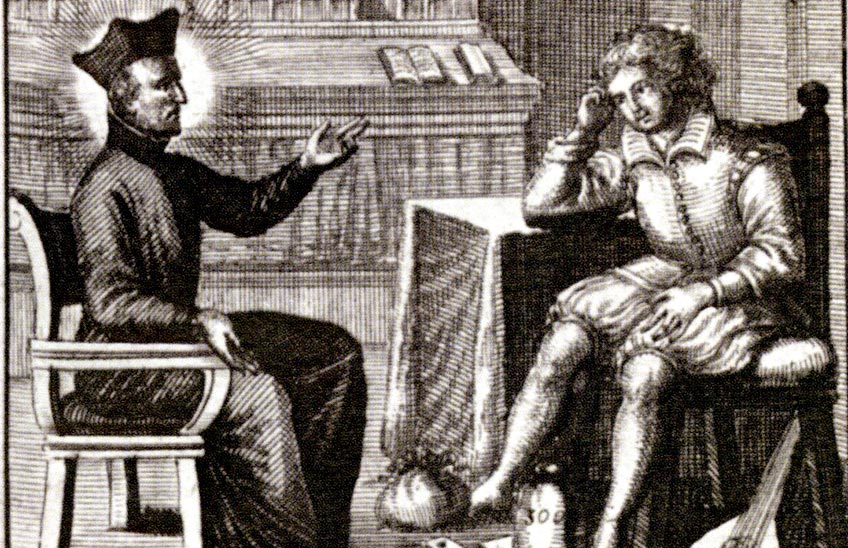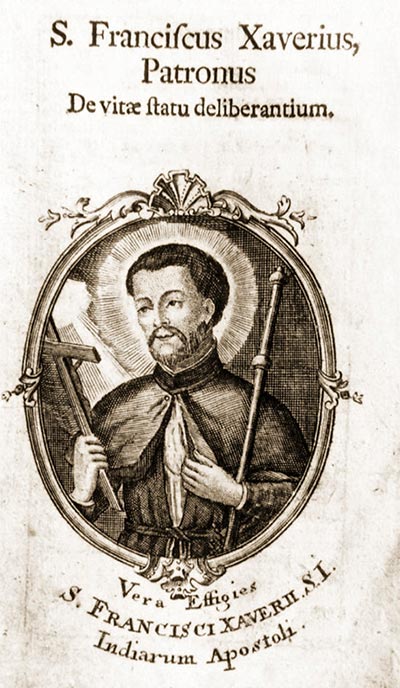St Francis Xavier invoked to take state

FotoCedida/Ignacio y Javier en <i>Vita Thesibus</i> (1690), publicado por G. Torres Olleta en <i>Vita Thesibus et Vita Iconibus</i>
In past centuries, the intercession of St. Francis Xavier was used as an advocate against the plague and the locust plague, at the hour of death, to go on missions, or when embarking on a long sea voyage. Some people were also entrusted to him at the time of taking state. In the latter case, the seals propose him as "Patronus de vitae statu deliberantium". In general, it is not a question of a special iconographic subject , but of placing ourselves before his image, either as a pilgrim, apostle of the Indies, or in the very scene of his death. We have already referred to some of them in a work on the patronages of the saint, in the Catalog of the exhibition of 2005.

Engraving from the 18th century that sample Javier as patron to take state. Xavier, Schurhammer Fund
Among the engravings that represent him for the aforementioned intercession, the one in the work of the Jesuit André Eschenbrender (1676-1739), dedicated to Saint Francis Xavier and entitled Instructio pro eligendo vitae statu clara, brevis et solida et variis probatisque Authoribus excerpta, Omnibus de certo Vitae genere statuendo deliberantibus..., published in 1717 and republished on several occasions, stands out for its uniqueness and timeliness. In the one published in Cologne in 1733 (Sump. Wilh. Meternich), a print signed by J. A. Friedich, corresponding to the engraver Jacob Andreas Friedrich (1684-1751), was included.
The engraving shows a richly dressed young nobleman, holding a Crucifix in his hands and illuminated by a large sun with the anagram of the name of Jesus - the emblem of the Jesuits - in front of an elegant buffet, which contains the book of the Spiritual Exercises of Saint Ignatius of Loyola. Behind him is a painting of the Glory and Christ triumphant with a cross and a skeleton with a scythe. The lower part of the composition is occupied by symbols and attributes of all that is related to the glories of the world: a violin (music), various weapons and helmets (degree program military), necklaces, decorations, crowns and cardinal's capitals (civil and ecclesiastical honours), books (culture), coins (wealth), as well as a horn of plenty next to the terrestrial sphere. The intentionality of this authentic vanitas is made clear to us by the lower registration which identifies the young Xavier at the moment of his conversion, when St. Ignatius asked him what good the glories of this world were to him if he lost his soul. The text reads: "S. Fran. Xaverius de statu vitae deliberans / Quid prodest homini iucundum universum lucretur / animae suae destructam patiatur". Obviously, this decisive moment in Xavier's life was chosen to be depicted in the print and to illustrate a book on the subject.

Engraving of the saint as an advocate for taking state, by Jacob Andreas Friedrich (1733). Xavier, Schurhammer Collection
The topic of the vanity of the world was a favourite of the Baroque. To allude to it, jewels, weapons, watches, games, noble coats of arms, arms and books that spoke of all that was perishable were always used. In the case of Xavier and his conversation with Saint Ignatius, when the latter put forward the argument about gaining the world and losing eternity, it fitted in perfectly with the topic of the perishability of earthly things. In fact, the elements that appear in Friedrich's engraving had already been used in other prints relating to Xavier, as can be seen in Gabriela Torres' work and doctoral thesis thesis . We will focus on the one in the Vita S. Francisci Xaverii Soc. Iesu Thestibus Philosophicis illustrata ( Vienna, 1690), edited and studied by the aforementioned researcher, with numerous engravings inspired by the already known lives of the saint. In one of the illustrations we find Saint Ignatius speaking to the young Xavier, dressed in rich attire. At his feet are a violin, another stringed instrument, a score, a crown alluding to worldly glories, a bugle referring to fame, as well as some bags of money and a pack of cards. In the background, a large study table with numerous books, a sphere of the world and a painting with the image of the Virgin and Child. In the end, the same elements as in Friedrich's print illustrating the work of the Jesuit André Eschenbrender.
To find out more
BACKER, A and A., Bibliothèque de la Compagnie de Jésus, vol. III, Louvain, Editions de la Bibliothèque S. I., 1890, cols. 428-429.
FERNÁNDEZ GRACIA, R., "San Francisco Javier patrono. Imágenes para el taumaturgo de ambos mundos", San Francisco Javier en las artes. El poder de la imagen, Pamplona, Fundación Caja Navarra, 2006, pp. 154-199.
TORRES OLLETA, G., Redes iconográficas. San Francisco Javier en la cultura visual del Barroco, Madrid, Universidad de Navarra - Iberoamericana, Vervuet, 2009.
Vita Thesibus et Vita Iconibus. Dos certámenes sobre San Francisco Javier, edited by M. G. TORRES OLLETA, Pamplona, Reichenberger-Griso-Chair de Patrimonio y Arte Navarro, 2005.
